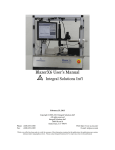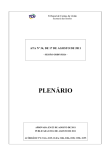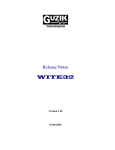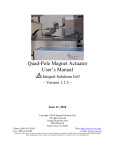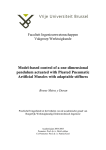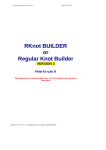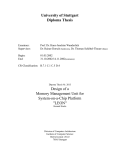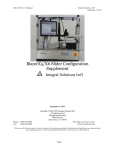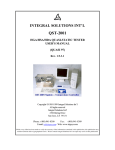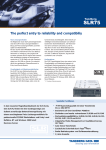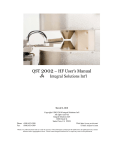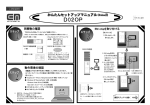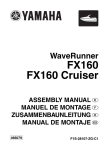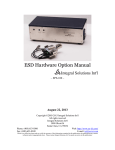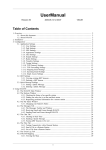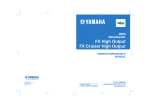Download QST Noise Report - us
Transcript
Quantum – Advanced Development Labs Comparison of the QST Noise Test to Other HGA Level Tests Mark Nichols, Advanced Test Engineer Advanced Heads/Media (Advanced Electrical Characterization) Quantum Advanced Development Labs – March 26, 2001 INTRODUCTION Recently there has been a great deal of interest in documenting instabilities in GMR heads. One of the primary methods used to investigate these instabilities has been to capture MR transfer functions showing resistance vs. applied field using a quasistatic tester (QST). Unfortunately this method has many drawbacks, including: no successful 100% correlation to decreased head performance [1], no stresses at different field levels, minimization of transient events due to averaging, and reduced statistical accuracy due to limited numbers of test iterations. The QST Noise Test is part of the standard ISI QST test software package, which has only recently been debugged to the point that it has become useful. The ISI software and manuals call this a popcorn test [2], unfortunately it does not exclusively detect popcorn noise, nor has it detected a true popcorn event to date. It should be mentioned that this is not due to any weakness in the software, just that heads with popcorn events are rare today, just as other types of head instabilities were rarer in the past. The basic algorithm that the QST Noise Test uses is as follows: it excites the head with a write event, waits for a user defined number of microseconds to avoid noise unrelated to the head, digitizes a user defined duration read window, before finally checking to see if any digitized point in this window exceeds a user defined threshold. This process is run repetitively at different amplitude thresholds and fields to create 3D transient count vs. amplitude threshold vs. field plots. These complicated 3D plots can be converted into a simpler 2D average maximum amplitude vs. field plots. Sample plots and mathematics are included in the QST Noise Test Setup appendix at the end of this document. The point behind constructing average maximum amplitude vs. field plots is to quantify amplitude instability associated with kinks seen on transfer curves. The use of average maximum amplitude is important because many traditional amplitude measurements minimize the effect of infrequent transient events. For example Guziks generally measures track average amplitude (TAA), which is the average amplitude seen over one disk revolution at a given track position. Thus if an instability adds an additional 10% amplitude to 1% of the pulses, it will show up as an additional point one percent (0.1%) TAA, but could result in all affected bits being read incorrectly (1% error = 1e-2 BER). The main focus of the experimental portion of this report is to compare the QST Noise Test to other HGA level tests, such as QST transfer curves & DET testing. EXPERIMENTAL SETUP All DET tests were run on a Guzik 1701 spin-stand, equipped with 961+ ANA, a 1632 RWA, WITE32 v. 2.56 software, and a Philips TDA5360 preamplifier with a high frequency bandwidth of 240 MHz. All AC-SNR measurements were made using a LeCroy DDA-120 capable of capturing 2GS/s. All BER and MSE measurements were made using custom Westlake hardware using a Rembrant channel. All tests were run with a 160MHz (1T) data rate. All QST tests were run on an ISI 2002-QST, using 2002-compatable HGA cartridges, Quasi97 software version 2.0.6. QST transfer curves were run from -200 to 200 Oe, with 0.2 Oe steps, with no averaging, or stresses. The QST Noise Test setup was developed in the course of this work and is detailed in the QST Noise Test Setup appendix. IPA was used in all head mounting processes to reduce tribo-charging & handling related ESD events. [email protected] March 26, 2001 Quantum – Advanced Development Labs EXPERIMENTAL RESULTS Thirty (30) as-received Atlantis20 MKPI heads were screened, using QST transfer curves, to find five (5) ‘kinked’ heads. Kinked heads are heads with non-uniformities in their transfer curves which have been traditionally associated with damaged or defective GMR elements. Recently kinks have been sub-categorized as ‘hard kinks’ or ‘soft kinks’, where a hard kink is an instantaneous change in resistance at given field (infinite local transfer curve slope), and a soft kink is a increased sensitivity over a range of fields (increased transfer curve slope). Hard kinks often appear with ‘open loops’, which are quantified as transfer loop hysteresis values. This transfer curve hysteresis is the area enclosed by a positively swept transfer curve (red curve in the figures below), and a negatively swept transfer curve (green curve in the figures below). Extensive QST & DET data was collected for the five (5) sorted kinked heads and ten (10) non-kinked control heads for comparison. Captured QST transfer curves and QST noise plots for the kinked heads are as follows (dotted lines on QST noise plots indicate the maximum experimental data point): Transverse Transfer Curve Bias: 4.5 Part ID: A20-02 Head: FarHd 0 Forward 500 Reverse 2000 400 1500 Average Amplitude (uV) 1000 Amplitude (uV) 500 0 -500 300 200 -1000 100 -1500 -2000 0 -200 -150 -100 -50 0 50 Magnetic Field (Oe) 100 150 -200 200 -150 -100 -50 0 50 100 150 200 Magnetic Field (Oe) Figure 1. QST transfer and 2D noise curves for head A20-02, showing multiple hard kinks &open loop centered at 0 Oe Transverse Transfer Curve 400 Bias: 4.5 Part ID: A20-16 Head: FarHd 0 Forward Reverse 350 1500 300 Average Amplitude (uV) 2000 1000 Amplitude (uV) 500 0 -500 250 200 150 100 -1000 50 -1500 0 -2000 -200 -150 -100 -50 0 50 Magnetic Field (Oe) 100 150 200 -200 -150 -100 -50 0 50 100 150 200 Magnetic Field (Oe) Figure 2. QST transfer and 2D noise curves for head A20-16, showing a hard kink at 150 Oe and a soft kink at -100 Oe. [email protected] March 26, 2001 Quantum – Advanced Development Labs Transverse Transfer Curve Bias: 4.5 Part ID: A20-18 Head: FarHd 0 400 Forward Reverse 2000 350 1500 300 Average Amplitude (uV) 1000 Amplitude (uV) 500 0 -500 250 200 150 -1000 100 -1500 50 -2000 0 -200 -150 -100 -50 0 50 Magnetic Field (Oe) 100 150 200 -200 -150 -100 -50 0 50 100 150 200 Magnetic Field (Oe) Figure 3. QST transfer and 2D noise curves for head A20-18, showing a soft kink at 0 Oe. Transverse Transfer Curve 400 Bias: 4.5 Part ID: A20-20 Head: FarHd 0 Forward Reverse 350 1500 300 Average Amplitude (uV) 2000 1000 Amplitude (uV) 500 0 -500 250 200 150 100 -1000 50 -1500 0 -2000 -200 -150 -100 -50 0 50 Magnetic Field (Oe) 100 150 -200 200 -150 -100 -50 0 50 100 150 200 100 150 200 Magnetic Field (Oe) Figure 4. QST transfer and 2D noise curves for head A20-20, showing a soft kink at 40 Oe. Transverse Transfer Curve Bias: 4.5 Part ID: A20-27 Head: FarHd 0 400 Forward Reverse 2000 350 1500 Average Amplitude (uV) 300 Amplitude (uV) 1000 500 0 250 200 150 -500 100 -1000 50 0 -200 -150 -100 -50 0 50 Magnetic Field (Oe) 100 150 200 -200 -150 -100 -50 0 50 Magnetic Field (Oe) Figure 5. QST transfer and 2D noise curves for head A20-27, showing a soft kink at -40 Oe. There are many interesting things to comment on in these plots. First of all it can be seen that the QST Noise Test seems to be tracking the positive going (red) transfer curve. This is because the QST Noise Test currently can only scan from negative fields to positive fields due to software limitations, so the noise test field history at a given field is identical to the positive going (red) transfer curve history, but different then the negative going (green) transfer curve history. [email protected] March 26, 2001 Quantum – Advanced Development Labs Second the QST Noise Test only indicates noise from kinks it sweeps over. For example very little noise is seen in QST noise plot for the soft kink at –100 Oe in head A20-16 in Figure 2. This because the field was not swept past the kink. The QST Noise Test field limits used here were set to approximate the field a head will see in a drive. The exact field limits these heads would see in operation is impossible to know as they would depend on many unknowns such as local media Mrt, fly height, pole tip recession, and local transition density (due to linear superposition of magnetic fields). Lastly the magnitude and field range of the kinks is very clear in the QST noise plots. For example the soft kink in head A20-20 in Fig. 4 is clearly smaller in the QST noise plot then the soft kink in A20-27 in Fig. 5 (both in field range and magnitude), which is not immediately obvious in the QST transfer curves or transition curve metrics such as Barkhausen jump noise or hysteresis (detailed later). Before moving on it should be reiterated that while transfer curve and noise plot data are both collected using a QST, the actual measurements are quite different. It is really quite exciting that there is such good agreement. DET testing was also conducted on these kinky heads, yielding the following data. Data points in red are considered outliers, where outliers are defined as data points outside the measured range of the ten control heads. Average non-kinked values have also been included in the ‘GOOD’ column for comparison. Table 1. DET & QST test results for five kinked heads & average of ten non-kinked ‘GOOD’ heads. ID Rmr RWoff Wwrite Wread LFTAA MFTAA HFTAA TAAasym PW50 PWasym (ohms) (3T, uin) (3T, uin) (3T, uin) (mV) (mV) (mV) (dB) A20-02 47.8 8.8 20.5 14.8 1.168 0.833 0.422 -1% 14.9 -2% A20-16 43.1 3.5 23.4 14.7 1.614 1.232 0.462 -5% 14.2 5% A20-18 47.1 8.7 21.1 11.1 1.347 0.974 0.278 -31% 13.8 11% A20-20 45.3 8.6 22.0 18.0 2.004 1.457 0.536 7% 13.4 -9% A20-27 42.7 0.5 21.9 15.3 1.898 1.472 0.531 -18% 14.8 7% GOOD ID 42.8 6.6 23.7 14.6 1.280 0.953 BLpop ACovr ACovw C-ACovr C-ACovw 1.06 1.35 1.67 1.23 2.17 7.43 0.64 1.35 0.95 0.39 8.33 0.36 1.10 1.71 0.76 7.77 0.37 0.86 0.80 0.38 8.21 0.26 1.15 0.81 0.65 GOOD 1.42 0.52 0.59 0.46 0.51 ∆AC-SNR (av. – inst.) 3.8 1.4 4.8 3.2 3.4 MSE BER 194 126 231 167 328 1.6e-4 1.0e-8 >1.0e-3 5.6e-6 2.9e-5 1.3 106 1.0e-10 A20-02 A20-16 A20-18 A20-20 A20-27 GOOD iAC-SNR aAC-SNR (dB) (dB) 14.2 18.0 18.3 19.7 10.0 14.8 16.2 19.4 15.2 18.6 18.6 19.9 0.9% 14.2 -0.5% Vsigma + Vsigma Vrange+ Vrange(SAS,mV) (SAS, mV) (SAS, mV) (SAS, mV) 0.052 0.049 0.163 0.141 0.035 0.034 0.109 0.117 0.088 0.094 0.280 0.228 0.057 0.056 0.135 0.169 0.075 0.079 0.207 0.311 A20-02 A20-16 A20-18 A20-20 A20-27 ID 0.366 0.026 0.027 0.091 0.086 QST BJ-Noise QST Hyst QST Slope (%) (%) (%) 15 4 350 4 2 288 2 2 101 2 1 92 2 1 316 [email protected] March 26, 2001 5 5 Quantum – Advanced Development Labs Again there are a number of interesting things in this data set. First of all QST transfer and noise plots showed all but head A20-16 were unstable in estimated normal spin stand conditions (had a hard or soft kink between -50 and 50 Oe, which caused increased average max amplitude in the QST Noise Test). Thus it was hoped one of the DET tests would flag all of these unstable heads. Analysis is as follows: Basic DET data (RW offset, read and write width, LF-, MF-, and HF-TAA, TAA asymmetry, PW50, and PW50 asymmetry) did not flag any of the unstable heads. With the possible exception of TAA asymmetry, which flagged two kinked heads (A20-18 & A20-27), but missed a very similar third head (A20-20). Thus this could be random scatter in the TAA asymmetry data. It should be noted that the sign of TAA asymmetry agrees (4/4) with the sign of kink field location. This is because kinks at negative fields are only seen by negative pulses, and kinks at positive fields are only seen by positive pulses. DET instability tests were not much better. Baseline popping detected one of the four (1/4) kinked heads, amplitude covariance with and without write excitation caught two of the four (2/4), and the Guzik’s sector amplitude stability flagged all of the unstable heads (4/4). All of these results are somewhat arguable in that it is not known if these tests were setup for optimal performance, and more data collection would probably be required before a true ‘good’ value is established for each test. Spin stand SNR results were also quite interesting. Instantaneous auto-correlation signal to noise (iACSNR), a metric which is considered to have a great deal more scatter then average auto-correlation signal to noise (aAC-SNR), was the better indicator of kinked heads, identifying all four (4/4), while aAC-SNR only identified one (1/4) kinked head. Hai Nguy suggested that this made sense as aAC-SNR attempts to measure ‘pure’ media noise by averaging, while iAC-SNR is a ‘raw’ noise which includes head & electronic contributions [4]. By calculating ∆AC-SNR (aAC-SNR – iAC-SNR) we find another good instability flag, which identifies all four (4/4) kinked heads. MSE and BER acted as expected with the ‘good’ heads having the lowest MSE and BERs. This is somewhat redundant, as BER (and indirectly MSE) are key metrics in identifying ‘good’ heads. So ‘good’ heads do in fact have ‘good’ BERs. Two transfer curve metrics have also been included for comparison: Barkhausen jump noise and hystersis. Both of these metrics correctly identified the hard kink, but missed the three soft kinks. This was expected as the soft kinks do not have large point to point deviations (Barkhausen jump noise) or open loops (hysteresis). The last metric that was evaluated was amplitude roll-off (TAA vs. frequency) plots. Once again the QST transfer curves have been included for reference: Transverse Transfer Curve Bias: 4.5 Part ID: A20-02 Head: FarHd 0 Forward 3.0 Reverse 2000 2.5 1500 1000 2.0 TAA (mV) Amplitude (uV) 500 0 1.5 -500 1.0 -1000 -1500 0.5 -2000 0.0 -200 -150 -100 -50 0 50 Magnetic Field (Oe) 100 150 200 0 100 200 300 400 500 Frequency (kfci) Figure 6. QST transfer curve and Guzik roll-off curve for head A20-02, showing hard kink at 0 Oe. [email protected] March 26, 2001 600 Quantum – Advanced Development Labs Transverse Transfer Curve Bias: 4.5 Part ID: A20-16 Head: FarHd 0 3.0 Forward Reverse 2000 2.5 1500 1000 2.0 TAA (mV) Amplitude (uV) 500 0 -500 1.5 1.0 -1000 0.5 -1500 -2000 0.0 -200 -150 -100 -50 0 50 Magnetic Field (Oe) 100 150 200 0 100 200 300 400 500 600 Frequency (kfci) Figure 7. QST transfer curve and Guzik roll-off curve for head A20-16, showing a hard kink at 150 Oe And a soft kink at –100 OE Transverse Transfer Curve 3.0 Bias: 4.5 Part ID: A20-18 Head: FarHd 0 Forward Reverse 2000 2.5 1500 2.0 TAA (mV) 1000 Amplitude (uV) 500 0 1.5 1.0 -500 -1000 0.5 -1500 0.0 -2000 0 -200 -150 -100 -50 0 50 Magnetic Field (Oe) 100 150 100 200 200 300 400 500 Frequency (kfci) Figure 8. QST transfer curve and Guzik roll-off for head A20-18, showing a soft kink at 0 Oe. Transverse Transfer Curve Bias: 4.5 Part ID: A20-20 Head: FarHd 0 Forward 3.0 Reverse 2000 2.5 1500 2.0 TAA (mV) 1000 Amplitude (uV) 500 0 1.5 1.0 -500 -1000 0.5 -1500 0.0 -2000 -200 -150 -100 -50 0 50 Magnetic Field (Oe) 100 150 200 0 100 200 300 400 frequency (kfci) Figure 9. QST transfer curve and Guzik roll-off for head A20-20, showing a soft kink at 40 Oe. [email protected] March 26, 2001 500 600 Quantum – Advanced Development Labs Transverse Transfer Curve Bias: 4.5 Part ID: A20-27 Head: FarHd 0 Forward 3.0 Reverse 2000 2.5 1500 2.0 TAA (mV) Amplitude (uV) 1000 500 1.5 0 1.0 -500 0.5 -1000 0.0 -200 -150 -100 -50 0 50 Magnetic Field (Oe) 100 150 200 0 100 200 300 400 500 600 Frequency (kfci) Figure 10. QST transfer curve and Guzik roll-off for head A20-27, showing a soft kink at -40 Oe. These roll-off curves do not appear very useful at first but there are many interesting details. First, the head with the hard kink and open loop (A20-02) produces a ‘noisy’ roll-off curve. This noise is unusual in that it does not diminish with averaging and seems to be jumping between two levels, one with more noise and one with less. This behavior suggests that the noise is not gaussian, but digital (jumping between two states). This makes sense after the transfer curve is examined, as there is an open loop. This open loop indicates the element could be in either a high or low resistance (amplitude) state at fields between the open loop limits. Thus a ‘noisy’ roll-off curve could be the signature of an open loop. The effect of a soft kink on roll-off curves is more subtle. The last three heads (A20 -18, -20, & -27) all have soft kinks, but only head A20-18 shows a dramatic effect. The soft kink appears to increase the rolloff curve slope at a frequency which might generate a maximum field equal to the kink field. There is of course no roll-off curve ‘noise’ as there are minimal open loops in these transfer curves (<2% transfer loop hysteresis). Heads A20-18 and A20-27 do not show a clear increased slope region. In the roll-off curves it is assumed that the media used in this study did not emit fields greater then 40 Oe. Or perhaps kinks above 40 Oe are obscured by the onset of linear superposition (which causes curvature in roll-off curves). EXPERIMENTAL RESULTS SUMMARY The following tests were used to detect known kinky heads, with correct kinky head percent in parentheses: QST transfer curves (4/4), this test was used to identify kinky heads. QST noise test (4/4), but media fields are assumed to be –50 to 50 Oe. Guzik parametric measurements (0/4) Guzik TAA asymmetry (2/4) Guzik baseline popping test (1/4), but possibly all hard kinks with open loops. Guzik amplitude variance (1/4) Guzik sector amplitude stability (4/4) Guzik roll-off curve spikes (1/4), but possibly all hard kinks with open loops. Guzik roll-off curve slope changes (1/4), possibly indicating soft kinks. External iAC-SNR averaged 3x (4/4) External aAC-SNR (1/4) External ∆AC-SNR (4/4) MSE & BER (4/4), this is somewhat redundant as BER was used to select good heads. [email protected] March 26, 2001 Quantum – Advanced Development Labs In summary, the Guzik sector amplitude stability seemed the best pure Guzik solution (involving no external hardware). Roll-off curves and base line popping seem to be tied at a distant second (with more data required to judge if it catches all open loops). iAC-SNR seems to be the best hybrid DET test, but requires external non-Guzik hardware. MSE & BER (which also requires extensive external hardware & software) are also excellent tests, though this is somewhat redundant as it was used as a metric for determining if a head was ‘good’ or not in the first place. CONCLUSIONS • QST transfer curves and the new QST Noise Test clearly identify kinked heads. • Standard DET tests are poor at identifying kinked heads, with the possible exceptions of: Guzik sector amplitude stability (an infrequently used standard Guzik test). Roll off noise & base-line popping, both which identified the one open loop kink in the study. TAA asymmetry which correctly identifies the polarity (+/- Oe) of a kink, if one is present. • iAC-SNR (which requires external hardware) identifies these kinked heads, but aAC-SNR does not. ∆AC-SNR (aAC-SNR – iAC-SNR) identified all kinked heads. • Kinked heads identified by QST tests but missed by DET show worse MSEs & BER. This does not mean they would fail self scan, but that they are inferior to non-kinked heads from the same wafer. REFERENCES [1] J.Himle, R.Cross, M.Greenwell, “Drive-Level Instabilities Correlated to Quasi-Static Field Testing”, MMM-Intermag 2001 (talk BB-01) preprint, Jan. 2001. [2] Integral Solutions Int’l, “QST-2001 HGA/HSA/HDA Quasi-Static Tester User’s Manual Rev.1.9.3.1”, www.isiguys.com, 1999. [3] W.Deming, “Some Theory of Sampling”, pp. 70-1. Dover Publications Inc., 1950. [4] G.Mian, T.Howell, “Determining a SNR for an Arbitrary Data Sequence by a Time Domain Analysis”, IEEE Trans. on Mag. V29(6) pp.3999-4001, Nov. 1993. THANKS Special thanks to: Al Wallash & Steven Lambert for resources and guidance. Hai Nguy, Bruce Lairson, Bill Higgins, Freddie Larios, and everyone else in Quantum’s Advanced Head/Media group for help and camaraderie. Everyone over at ISI for building the QST-2002, developing new tests, and fixing software bugs as quickly as we could find them. [email protected] March 26, 2001 Quantum – Advanced Development Labs Appendix I – The QST Noise Test Setup INTRODUCTION To improve MR instability characterization a new QST Noise Test has been implemented. ISI manuals and software refer to this test as a ‘popcorn test’ [2], but has been discovered that this test detects any transient noise spike. Thus this test will be refered to as the QST Noise Test for the remainder of this document. The QST Noise Test stresses the reader by passing current through the writer before capturing a short read window. It then checks to see if any ‘events’ exceed a given threshold. For example, it can count how often amplitude spikes above a given threshold. The strength of this test is that it can be run many times in a short period of time, so the true statistical nature of instabilities can be measured. The QST Noise Test runs this routine with different applied fields levels to quantify transient events at different points on the transfer curve. It should be mentioned that the write excitation is unnecessary in producing kink related transient events, but it would help detect heads with true popcorn noise. TEST SETUP The QST Noise Test require a 2002 or 2001+ generation HGA cartridge (with SMB cables connected), Quasi97 software version 2.0.6 or higher (released 3/01) and a high frequency popcorn board. QSTs with older hardware or software are not capable of running this test. To setup this test you must first configure QST hardware & software for conventional HGA testing [2], just as if you were going to capture the transfer curve for an HGA. This can be done by manually creating a new setup and configuring the system menu for the correct fixture & bias level, or by opening an existing HGA test setup. Once you have a setup open you should push the ‘popcorn’ button in the test menu bar. This should bring you to the Popcorn test window, pictured on the following page. The settings shown in the picture are the suggested QST Noise Test settings, and are described as follows: Cycles (number): the number of read windows sampled. At least 500 cycles is suggested to ensure good statistical sampling. More would be better, but this would also cause the test to take longer to run. Filter (selection): This selects which QST filter is used when reading. All data in this report was collected with the high frequency filter, but this was default and may require more thought. Test Mode (selection): This selects if the popcorn test is run in a single environment (set field, MR bias, threshold, write current, frequency, etc.) in popcorn mode, or if one or more parameters is swept (popcorn sweep mode). For a standard QST Noise Test the popcorn sweep mode is used. Amp/Rate Qualify (buttons): selects amplitude or change in amplitude (rate) as the metric for the threshold limit. Amplitude qualification is used in the standard QST Noise Test. Amp/Rate Threshold (values): Sets the amplitude or rate threshold (depending on which is being used). Note, these inputs are overridden by the popcorn sweep parameters below in sweep mode. Write current & frequency (values): This is the current and frequency used by the QST to excite the head preceding the read window. All noise documented to date has been independent of this write exc itation, thus changes in write excitation did not influenced QST noise results in any way (even at very low current write excitations). Write/Delay/Read Ties (values): These are the amounts of time the head is excited by a write event, delays before starting to read (to avoid switching & thermal ramp effects), and time the read window is open. Non-head related noise spikes have been recorded <1usec after the write (possibly due to electronic switching in the QST hardware) thus a 1usec delay is suggested. Also, as noted above all the noise measured to date has been write independent so changes in write duration do not seem to change QST noise results. Multi Events & Digitization (buttons): are debugging features that should be turned off when the QST noise test is run. More information on these features is available in the QST manual [2]. Sweep Parameters (selections): these entries determine what elements of the test environment are swept [email protected] March 26, 2001 Quantum – Advanced Development Labs during the QST noise test. Sweeping amplitude threshold and test field has proven the most useful in documenting GMR instabilities. Sweeping the threshold allows one to distinguish artifacts above the noise floor, while sweeping the field tests the MR element at different locations on the transfer curve. [email protected] March 26, 2001 Quantum – Advanced Development Labs The QST noise test balances two basic issues: time required to run the test and the level of detail the data contains. The QST noise test can be run quite quickly (less then 30 sec) if large amplitude threshold steps and short write excitations are used. Large threshold steps seem acceptable as all instabilities recorded to date have spanned multiple threshold levels. Likewise, short write excitation also seems acceptable as kink related instabilities seem to be independent of write duration. The following section illustrates sample QST Noise Test data for a head with a kinked transfer function. Note the QST Noise Test field must sweep beyond a kink to detect it, so small field sweeps are not advised. Transverse Transfer Curve Bias: 4.5 Part ID: A20-20 Head: FarHd 0 Forward Reverse 2000 1500 1000 Amplitude (uV) 500 0 -500 -1000 -1500 -2000 -200 -150 -100 -50 0 50 Magnetic Field (Oe) 100 150 200 Figure 1. Sample QST transfer plot for a head with a soft kink. Popcorn Test 314.0 500 300 200 100 ) (Oe Field 0 0 -10-9 0 -8070 - 0 -6 0 -5 0 -4 0 -3 -20 -10 73.3 98. 7 124 .1 149 .5 174 .9 0 10 20 0.2 20 225 .6 30 40 Thre sho ld (u V) Popcorn Count 400 251 50 60 27 6.4 1.8 30 90 80 70 10 0 Figure 2. Sample 3D event count vs. amplitude threshold vs. field QST Noise Test plot. [email protected] March 26, 2001 Quantum – Advanced Development Labs This 3D plot is rather tough to absorb, but it can be converted into a simpler 2D QST Noise plot using excel or other offline tools. Note the raw data must be recorded to accomplish this (by selecting ‘capture raw data’ in the data logging window). A sample 2D average amplitude vs. field graph is shown as follows. 400 350 Average Amplitude (uV) 300 250 200 150 100 50 0 -200 -150 -100 -50 0 50 100 150 200 Magnetic Field (Oe) Figure 3. Sample average maximum amplitude vs. field plot for a kinked head. Note, both the 3D and 2D plots contain the same information. The 2D graph converts the average max. amplitude cumulative hystigram into average max. amplitude values using the equation: Vav = Σ PiVi, where P is the percentage (events counted/total count) and V is the value (amplitude threshold). Average max. amplitude standard deviations can also be calculated using the equation: ST.DEV = [(Σ PiVi)2 – Σ Pi Vi2 ]1/2 [3]. [email protected] March 26, 2001












